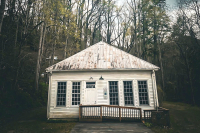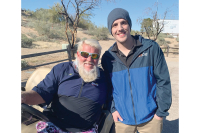To each his own: Nature week allows age-stratified exploration for families
 It’s day four of the Family Nature Summit, and the troops are working hard on a wooded piece of land behind the Lambuth Inn at Lake Junaluska.
It’s day four of the Family Nature Summit, and the troops are working hard on a wooded piece of land behind the Lambuth Inn at Lake Junaluska.
“I’ve planted trees before in a lot softer ground than this,” says Eden Lehr, 10, leaning on her shovel. “This ground is really tough.”
It’s rocky soil indeed, agrees project leader Brian Yinger. But he’s hoping to see a native plant garden thrive as a result, and that outcome would make the hard work all worth it.
“You get the right plants, you get the right bugs. You get the right bugs, you get the right animals,” he explains.
The bugs and plants of the Smokies are a little different than those in Yinger’s hometown. From Ohio, he’s in town for the 2015 Family Nature Summit, an annual event that’s always held in some different part of America known for its natural beauty. The program prides itself on providing an array of activities wide enough that each person, regardless of age or fitness level, can spend the day exploring in the way that works best for them. Children can embark on kid-friendly outings while their parents complete challenging hikes, go birding or even take a class in painting or soap-making. Most of the programming is recreation-based, but each year the Summit incorporates a service project into its itinerary.
This time, they set their sights on creating a native plant garden similar to the Corneille Bryan Native Plant Garden, which is also at Lake Junaluska. The difference is that the new garden, dug into a previously poison-ivy-filled piece of land behind the Lambuth Inn, will be easier to get to and accessible to people with disabilities. It’s got the blessing of the National Wildlife Federation, deemed a Certified Wildlife Habitat through the organization’s Garden for Wildlife Program, which aims to encourage responsible gardening so that pollinators and other kinds of wildlife can thrive in garden habitats.
Related Items
The environmental value of the project wasn’t lost on the young gardeners who took their shift at service last Wednesday.
“A tree helps the environment,” explained 12-year-old Hannah Bernstein. “It cleans up the bad air.”
So does teaching people to love trees, explained Brian’s mother Sue Sabo, who serves as the Summit’s programming and recruitment director.
“People will save what they love, and that’s part of our mission — getting people out in nature doing fun things but also paying attention to what they’re seeing,” Sue said.
Sue’s been going to the Nature Summit since 1991, when Brian was just 7 years old. Now, Brian comes with his two daughters, making it a three-generation family event.
That almost wasn’t possible. The National Wildlife Federation had been holding the summits since 1970, but in 2006 the organization announced that the event would have to go. It was simply losing too much money.
“A group of us said, ‘Oh no, wait!’” Sabo recounted. “This is too important.”
The Summit’s many hardcore adherents wouldn’t let it go. With the NWF’s blessing, they took it over as a volunteer effort.
Fidelity to the Summit is high. It’s not hard to bump into someone who’s been attending since before they learned to read, making this week of outdoor discovery almost part of their DNA. Summit-goers wear scarves tied to their wrists or hanging from a pocket, the color indicating how many years they’ve been part of the family. The numbers go pretty high, with those donning a robin’s egg blue scarf having come for 25 years or more.
For Chad Byrum, 36, the color is yellow — a rare first-year scarf. It hasn’t taken him long to get on board.
“I’ve already fallen in love, and I’m planning on coming back next year,” he said.
“Back” meaning to the Nature Summit, which in 2016 will be held in New Mexico. But he’ll return to the Smokies long before then. His girlfriend’s family, longtime Summit-goers, have already booked a cabin for later in the summer.
From Charlotte, Byrum and his girlfriend Leah Winstead had at least dipped their toes into Western North Carolina before this summer, but it had been a while. And never had they had the flat-footing, whitewater-riding, elk-viewing experience that they did this time. They’re leaving more than convinced this is a place they’ll have to visit more often.
“We go to places that are special national treasures, and this area is a national treasure,” Byrum said.
The Summit lets its participants explore those treasures in a way that trumps a solo itinerary, serving as a magnet to bring in experts in everything from wildlife to geology to botany to elucidate the area in a big way.
“A lot of people that attend here have some sort of environmental job. They have the connections to be able to find these specialists and pull them in,” said Sarah Houser, Winstead’s sister. “Connections are basically how things are done.”
Hopefully, the connections transcend the weekend itself. The Summiters will return to their homes, from Oregon to Florida, with pictures of the Smokies on their cameras, passion for Western North Carolina’s natural beauty in their hearts and the memory of hand-planted native trees in their minds.
“It’s about giving back and learning,” Sue said.
The rapid king
Alex Locher, 10, is no stranger to the Family Nature Summit, but until this year he was a newbie when it came to whitewater rafting.
So, when the fourth-year Summit-goer’s raft — laden with a guide from Nantahala Outdoor Center and a load of other kids his same age — neared a churning rapid on the Nantahala River, he was a little nervous. Not exactly scared, though, because he had some experience in this department.
“I’ve been on all kinds of roller coasters,” Locher said.
So, he took a deep breath, gripped his paddle just like he’d been taught to, and obeyed the orders coming from the guide at the back of the boat. They made it through, creating Locher’s favorite memory from the 2015 Family Nature Summit in the process. They also got soaking wet.
“It was a good thing we had a change of clothes,” he said.
Hunting for butterflies
The flowerbeds outside Lake Junaluska’s Lambuth Inn are covered in blooms this time of year, making them a natural place to begin a butterfly hunt.
But that’s not where Jeff Harding, butterfly net in hand, led his group to search for the colorful Lepidoptera species.
Butterflies and moths are sensitive creatures, he explained. With the sky overcast and rain threatening, they might be hunkering down rather than flying around. Skippers, however — a family of species similar to, but not the same as, true butterflies — might be a more probable find.
“A lot of skippers feed on grass as a host plant,” he said, shuffling his feet through the lawn, hoping to flush one out.
Soon, a skipper appeared, though not from the grass. It flitted along the inn’s wall, then through the garden, and, finally, to the grass, where Harding netted it. He carefully lifted the tip of the net, causing the insect to climb to the top, then reached under with a plastic bag to capture the skipper in a more viewer-friendly manner.
The group crowded around, getting an up-close view of the skipper’s markings and Harding’s field guide before he opened the bag, allowing the skipper to fly and the group continue its quest for butterflies.
Sunlight in Cataloochee
The hike along Boogerman Trail didn’t have the most auspicious start for Marietta, Georgia, resident Geri Gagat. Like many summer mornings in the Smokies, it was rainy and foggy — a rather depressing way to start a 9-mile hike.
But things can change quickly. The rain began to clear as Gagat’s group, led by Asheville hiking guide and author Danny Bernstein, hiked through the verdant forest of Cataloochee Valley in the Great Smoky Mountains National Park, passing by remnants of old stone walls pointing to the existence of those who called this place home before the park was thought of.
The group took a late morning rest, and sunlight began to break through the clouds, right over a cove covered in blooming rhododendrons and big tulip-poplar trees. That moment would become Gagat’s favorite memory from the entire Family Nature Summit.
“It was absolutely gorgeous,” she said.
Sign up for 2016
The 2016 Family Nature Summit will be held July 2-8 at Ghost Ranch in Abiquiu, New Mexico. The ranch is located in the Carson National Forest near the home of 20th century artist Georgia O’Keeffe and features red rock desert, dinosaur quarries, green forest and paddling on the Rio Chama and Rio Grande.
Space is limited. Sign up at www.familynaturesummits.org/next-summit.









